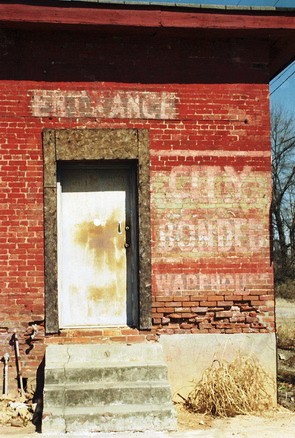 Last time, we were leaving James Brown Blvd. and heading downtown. However, The Trip of a Lifetime, a story carried in The Guardian a couple of years ago, suddenly changed our mind. Thus, instead of turning right off Walker St., we meandered around and eventually turned left. In The Guardian story, James Brown visits his childhood home, a brothel run by his Aunt, at 944 Twiggs St. The article describes the house as "abandoned and bristling with weeds." Now, if you think I'd pass up the chance to visit the abandoned brothel that The Godfather of Soul grew up in, and possibly get inside to take some photos, well, you haven't seen much of this site. However, I have no pictures of 944 Twiggs St. Nor do I have any photos of Hopkins St., also mentioned in the story. In fact, I have no shots of JB Blvd. south of Walton Way. In this post, I'll describe why that is, though I've touched on it briefly before, and include some photographs that are as close as we're gonna get. This is a shot of a warehouse along the railroad tracks just north of Walton Way.
Last time, we were leaving James Brown Blvd. and heading downtown. However, The Trip of a Lifetime, a story carried in The Guardian a couple of years ago, suddenly changed our mind. Thus, instead of turning right off Walker St., we meandered around and eventually turned left. In The Guardian story, James Brown visits his childhood home, a brothel run by his Aunt, at 944 Twiggs St. The article describes the house as "abandoned and bristling with weeds." Now, if you think I'd pass up the chance to visit the abandoned brothel that The Godfather of Soul grew up in, and possibly get inside to take some photos, well, you haven't seen much of this site. However, I have no pictures of 944 Twiggs St. Nor do I have any photos of Hopkins St., also mentioned in the story. In fact, I have no shots of JB Blvd. south of Walton Way. In this post, I'll describe why that is, though I've touched on it briefly before, and include some photographs that are as close as we're gonna get. This is a shot of a warehouse along the railroad tracks just north of Walton Way. 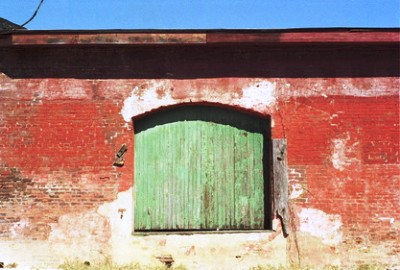
On the downtown flats sits a relatively small, rectangular set of streets. This area is bounded by Walton Way to the north, and Laney-Walker to the south, with a trainyard and miles of open swampland beyond. To the east is Magnolia Cemetery, encased behind a high brick wall. To the west are more tracks, and then the landscape changes as one approaches the medical colleges. This rectangle was known historically as "The Terry," short for "Negro Territory." Within these boundaries Augusta's poorest and most dangerous neighborhoods are located. I've heard that police don't bother to patrol the streets, some of which are said to still be unpaved, and virtually no one I know has ever turned off Walton Way or Laney-Walker to see if the rumors are true. Well, I did, but we'll get to that. We're moving slow, so we're still checking out the warehouse in the photo below.
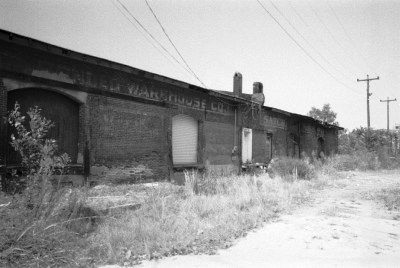
As the 2005 Master's Golf Tournament is wrapping up, I'll be a spoil-sport and mention an unpleasant event that used to take place at the once-grand Bon Aire Hotel, now a nursing home, much farther up Walton Way, on The Hill. In the 1930's, members of Augusta National Golf Club would recruit young black men, mostly from The Terry, and have boxing matches. In these matches, six men all fought at once, each blind-folded, and often with one arm tied behind their backs. These free-for-alls were a tradition, and club members dressed up in their finest for the matches. It's been said that James Brown participated in some of these bouts, which is possible only if they continued well into the 1940's, or if Brown's real birthdate is earlier than 1933, as has been speculated. Incidentally, the first African-American joined the Augusta National Golf Club in 1990, although Lee Elder had been playing the course since the 1970's. Now, of course, the controversy is over whether the Club should admit women.
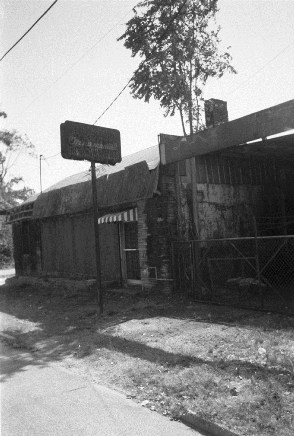 As I mentioned, I don't know anyone that can tell me much about this part of the flats. In all honesty, it's probably best that way. Most of my friends in Augusta, like me, are white males, considered to have only two reasons for being in this particular area: 1.) drugs; and/or 2.) prostitutes. It's unfortunate, but residents and police, not to mention dealers and hookers, all know that to be the case. Therefore, it seems disrespectful to me to go into these neighborhoods to "check it out, man," when these folks are having a hard enough time without wacko urban tourists coming down and getting themselves into trouble. This is a mysterious photo of the Augusta Iron Works, actually very close to James Brown Blvd., and a street down from Walton Way. I know you can't see much, but there it is. At least for now.
As I mentioned, I don't know anyone that can tell me much about this part of the flats. In all honesty, it's probably best that way. Most of my friends in Augusta, like me, are white males, considered to have only two reasons for being in this particular area: 1.) drugs; and/or 2.) prostitutes. It's unfortunate, but residents and police, not to mention dealers and hookers, all know that to be the case. Therefore, it seems disrespectful to me to go into these neighborhoods to "check it out, man," when these folks are having a hard enough time without wacko urban tourists coming down and getting themselves into trouble. This is a mysterious photo of the Augusta Iron Works, actually very close to James Brown Blvd., and a street down from Walton Way. I know you can't see much, but there it is. At least for now. After saying all of the above, I did finally break down and take a short trip through on a couple of occasions, basically driving a straight line from Walton Way to Laney-Walker and back. Yes, there's plenty of places that had been torched, and homes that were barely livable, though lived-in they were. I recall a large, two-story building that had obviously been a bar. The doors were wide open and, normally, I'd be unable to resist. James Brown, referring to these neighborhoods, said, "You look at this, it kinda take your breath."
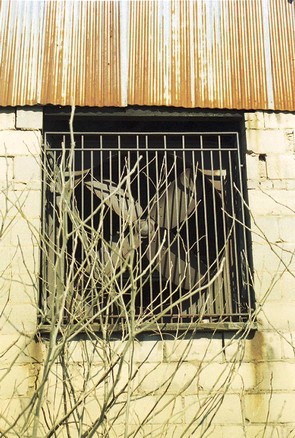 But there were also well-kept homes with flowers and lawns, and it was the looks I received from the owners of these residences, more than anything, that convinced me not to start wandering around. They didn't look pleased to see me, and followed my car closely as I passed. I don't consider this racism, nor do I believe it's a class issue (my car is worth about $300). As I mentioned, it's likely these people simply figured I must be looking for drugs, prostitutes, or some kind of trouble. To get out and start walking around with a camera, taking pictures, would be the height of audacity/stupidity. This is the back of the Augusta Iron Works.
But there were also well-kept homes with flowers and lawns, and it was the looks I received from the owners of these residences, more than anything, that convinced me not to start wandering around. They didn't look pleased to see me, and followed my car closely as I passed. I don't consider this racism, nor do I believe it's a class issue (my car is worth about $300). As I mentioned, it's likely these people simply figured I must be looking for drugs, prostitutes, or some kind of trouble. To get out and start walking around with a camera, taking pictures, would be the height of audacity/stupidity. This is the back of the Augusta Iron Works.In 1967, Canadian filmmaker Hugh O'Connor was shot and killed by Hobart Ison. Ison lived in Letcher County, Kentucky, in the Appalachian Mountains, where Lyndon Johnson had declared a "War on Poverty" in 1964. O'Connor was making a film at the behest of the U.S. Department of Commerce which was to show the many facets of American life. A scene was being shot during which a woman went to a common well to draw water. The well was on Ison's land, but Ison hadn't been told of the filming. Eventually, the crew was warned that Ison, gun in hand, was on his way, and began to pack up. Ison arrived, screaming "Get off my property!", and began firing. Some members of the crew thought the bullets were blanks. O'Connor turned to tell Ison they were going, and was shot in the chest. A movie was eventually made, released recently, called Stranger with a Camera. The film is directed by Elizabeth Barrett, who grew up in eastern Kentucky. "Can filmmakers show poverty without shaming the people we portray? I came to see that there was a complex relationship between social action and social embarrassment. As a filmmaker, I live every day with the implications of what happened." Ison wasn't the only member of the community who saw the filmmakers as "do-gooders" and "outsiders." Below is Sonny Boy's Barber Shop, and, despite what I said last time, we're actually back on JB Blvd. for a moment. Sonny's is gone now, and all that remains is a black and white checkerboard floor and a pile of glass block.
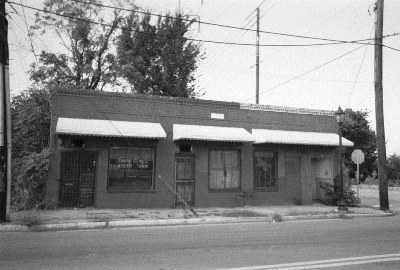
We're on the edge of Walton Way, but we won't cross the street. James Brown can drive his limousine through, because this is where he's from. It also doesn't hurt that he hands out $50 bills to residents. But, even without his generosity, he is not an outsider, and everyone knows he's not looking at them as "the other." Not so for me. I might take photographs if someone from the neighborhood offered to show me around. But maybe not. Such places are best documented by those who live there, who, given the means, could do a better job than I. For a northerner, such feelings seem even more pronounced in the South. Writer and SC-native Dorothy Allison has said something like, "Nowhere are you more aware that you are an outsider, who will never entirely fit in, than when you are in the South." No matter how comfortable you get, if you weren't born in the South, you will always find yourself somewhere, at some time, knowing that you are different. Then again, this can be just as true, if not moreso, on the street where you were born. I've been in abandoned restaurants, movie theaters, and motels, but never a strip club. I badly wanted in, but, as open buildings in this area are quickly occupied, the one below was sealed up like a fortress.

James Brown: "They want me to help build this place back. What can I do? Get on my knees and pray, and ask, 'Mr President, come. Mr Bush, come in here and clean it out and put decent homes in here'?" We'll turn back now and start heading downtown again. On our way, we pass this cement factory. At least, I think it's a cement factory. Thomas Croft, who wrote an interesting article on Augusta National Golf Course, has quoted his mother as saying, "Augusta is damned near three hundred years of history unblemished by progress." That, of course, depends on your definition of progress and your patience with the process. Next time, as usual, we'll look at more of the Augusta that hasn't progressed. Or is progressing back into that whence it came.
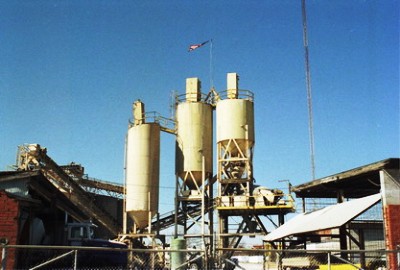
7 comments:
Good post. It's good to know the Godfather of Soul has street cred. BD
I go around Jacksonville and Duval County taking 'happy' pics, but here, too, is a very seemy side. I may have mentioned this in a comment previously.
Like you, I long to go into these sections and photograph, but I feel uncomfortable doing it, as though I'm the invader profiting from someone else's lowly means, although I have not come across any neighborhood quite as rough as you describe.
As far as never being accepted if you weren't born here, Jacksonville is a little different. The military brings in so many people who decide to stay when their tour is up that the native population can't be more than 40%. Though a Yankee by birth and decades of living, I always feel more a southerner than many of the Southerners I meet. I descend from two men who gave their lives in combat for the Confederacy, and having paid the highest price, I claim (in accordance to the payment made) the south as my own. It wouldn't matter though if I wasn't descended from war vets. In the spirit of Juan Ponce de Leon, I'd just claim it anyway.
Hi JMHouse. I came across your blog while doing research on Twiggs Street in Augusta, Georgia. I found your writing intersting considering that I have lived in this area for nearly 36 years and hold this city near and dear to my heart.
It would have been perfectly safe for you to travel throughout "The Terry". (Thank God it's not called that anymore.) The individuals who live here wouldn't have hurt you. Would they have been curious about who you were, perhaps yes, but no one would have approached or said anything to you. Why should they?
It's unfortunate that you did not take full advantage of your surroundings. You could have talked to the neighbors and received a wealth of information to include in your blog. You definitely would have had more photos to choose from...which by the way are georgeous, you're a good photographer.
Instead you believed and were influenced by the normal, stereotypical rumors
about the area. These rumors are false...the streets are paved, police are not afraid to patrol the area, and people of all colors drive the streets with few residents suspecting that they are there to buy drugs or pick up a prostitute. Hard-working, productive citizens of all ages live in this community. How do I know this? For 26 years I have proudly attended a church just off of Twiggs Street and have seen what goes on in the area.
Please contact me at www.myspace.com/blessedgirlt or www.myspace.com/watchingforhim the next time you want to photograph the area around Twiggs Street. I would be more than happy to show around.
Sincerely,
Tawanda from Hephzibah
Hi Tawanda,
Thanks very much for your comment. I really appreciate it and wish that I was able to take advantage of your offer to tour the neighborhood. At the moment I'm on my way to my new home in California. However, I have to admit that you're right: I did give in to the rumors. Not being a native to Augusta, I could only go by what people told me. When I did break down and drive through, I was primed to misinterpret the looks I recieved. Also, the article on James Brown that I quoted painted a pretty grim picture. I had to keep my eyes peeled while walking James Brown Blvd., so I just assumed that the area around Twiggs was as bad as I'd been led to believe. Now, re-reading the post in consideration of your message, I wish that I'd just gone ahead and had a look around. I usually know better than to go by what people tell me--few places are as bad as most rumors would lead you to believe, as evidenced by other places I posted about--and I fear I really missed a good opportunity to not only dispel some misconceptions, but get some interesting pictures and document an area that is obviously not well-understood. With the invitation of a resident I would have gladly gone for a tour and if I return to Augusta in the future I would certainly like to take you up on your offer. Again, thanks, and if you have any information about the neighborhood that you would like to post, I'd gladly offer you this blog as a forum. John
Thanks for the response John. I would be glad to show you around the next time you're my way. I pray that God will keep you safely in California and that you will love your new home. May you discover seen and uncover hidden jewels in your area. I have saved your blog under my favorites and will check your site from time to time to see what's new. Incidently John, my husband remembered my password to my blogspot. (I've been on MySpace for so long that I forgot it.) Feel free to take a look.
God bless you and yours!
Tawanda from Georgia
Thanks very much for your kind words, Tawanda. I appreciate it immensely. I haven't gotten many new posts up recently, but they'll show up eventually, once I have some time. And, with luck, I'll be able to take you up on your fantastic tour offer someday.
God bless you and yours, too.
John
I'll have to check out Stranger With A Camera later... sounds very interesting. I've heard of similar instances of aggressiveness and violence toward photographers, but rarely to this extent and this highly publicized.
Post a Comment